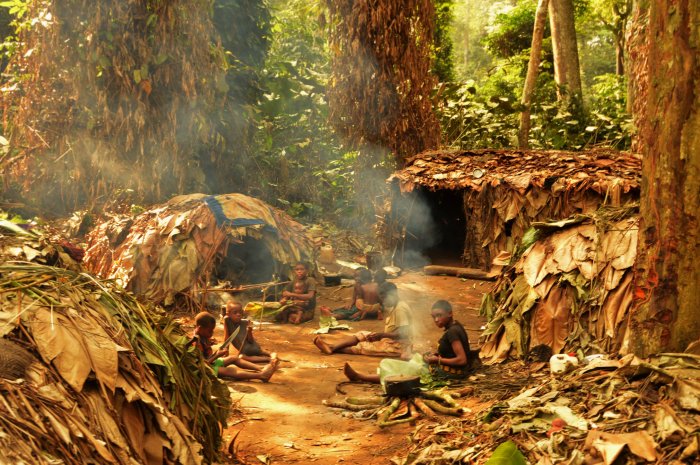Jan Bartek – AncientPages.com – Infants and toddlers may be psychologically wired to thrive with high levels of “sensitive care” and personal attention, according to a study conducted with contemporary hunter-gatherer societies.
Research led by an evolutionary anthropologist at Cambridge University found that hunter-gatherer infants receive attentive care and physical contact for about nine hours per day from up to 15 different caregivers.

Dr. Nikhil Chaudhary says that, for the vast majority of our species’ evolutionary history, mothers probably had far more support than they currently do in Western countries such as the UK.
He argues that recent changes in UK policy show childcare is becoming more of a priority for the government, which is a step forward, but more needs to be done to ensure the well-being of mothers and children.
“For more than 95% of our evolutionary history we lived as hunter-gatherers. Therefore, contemporary hunter-gatherer societies can offer clues as to whether there are certain child-rearing systems to which infants, and their mothers, may be psychologically adapted,” said Chaudhary.
However, caution should be exercised before jumping to conclusions, argues Chaudhary., “Many aspects of our psychology have evolved to be flexible rather than best suited to one specific way of life . The extent to which this is true for childrearing is still debated.”
For the latest research, Dr. Chaudhary and his colleague Dr. Salali worked with Mbendjele BaYaka hunter-gatherers who reside in the Republic of Congo, and have been analyzing and interpreting the findings alongside a child psychiatrist, Dr. Annie Swanepoel.
In the new paper, published in Developmental Psychology, the researchers say that children may be “evolutionarily primed” to expect exceptionally high levels of physical contact and care, as well as personal attention from several caregivers in addition to their biological parents.
When considering the implications for Western countries, the authors highlight that the provision of affordable high-quality childcare support, which goes beyond effective supervision, should be prioritized. Higher caregiver-to-child ratios, and stability of key caregivers in nurseries and insтιтutional care, may be important for minimizing risks to well-being.
In the observed hunter-gatherer communities, caregiving goes so far beyond the parents, according to the researchers. Children often have 10+ caregivers and occasionally 20 or more, and typically a mother’s support system would help respond to more than half of her baby’s episodes of crying, which can be one of the most challenging aspects of parenting.
“Support for mothers also has numerous benefits for children such as reducing the risk of neglect and abuse, buffering against family adversity, and improving maternal well-being which in turn enhances maternal care,” said Dr. Swanepoel.
The study found that it was common for older children and adolescents to be heavily involved in caring for infants, further supporting mothers and giving these young caregivers valuable experience. The researchers speculate that this might boost their confidence as caregivers, and perhaps offer some protection against the anxieties often experienced by first time parents.
The authors also point out that in Western societies it is common for childcare to be used simply to allow parents to work, but insist that childcare needs to give parents an actual break. They argue that throughout human history and prehistory, parents have never been under the pressure they are now in terms of lack of support.
“The nuclear family system in the west is a world away from the communal living arrangements of hunter-gatherer societies like the Mbendjele,” said Chaudhary. He says that changes in UK childcare policy, such as expanding free childcare to include younger children, are an important step.
However, both of these schemes are only available for working families and further contribute to childcare only being available for parents to fill the ‘freed’ time with work, rather than rest.
Ratios of caregivers to children were greater than five-to-one in the observed hunter-gatherer groups, whereas in UK nurseries each adult is responsible for numerous children. In fact, regulations on adult-to-child ratios in early years settings have recently decreased for two-year-olds to one caregiver for five children—the opposite of what the researchers observed in the Mbendjele communities.
Despite the high numbers of caregivers, the study suggests that children may be adapted to have a stable set of a core caregivers within this larger network. Mbendjele children benefit from the supplementary care of many people, but retain access to personal attention and consistency from a handful of key caregivers.
This is in line with previous research suggesting a potential link between instability of caregivers and issues with emotional and cognitive development, says Chaudhary, who is concerned that many childcare and education settings in the UK currently face a staffing crisis, and rely on ever-changing agency staff.
“Childcare is finally becoming a priority in the government’s budget, but there is much more to do,” Chaudhary added. “As a society, from policy makers to employers to health care services, we need to work together to ensure mothers and children receive the support and care they need to thrive.”
The study was published in the journal Developmental Psychology
Written by Jan Bartek – AncientPages.com Staff Writer





